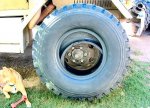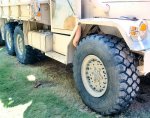It's simply a matter of staying calm & making yourself keep your wits about you...having somebody else with you won't give you that. I have thousands of hours in the passenger seat as a driving instructor, so I know having someone qualified sitting next to you does little good (sometimes it is actually worse, as the driver is more worried about what the passenger is doing/thinking instead of focusing on driving).
The key is to not panic, and hold the wheel so the nose of the truck continues going STRAIGHT. Yes, the first one is a little disconcerting, but during subsequent front tire blowouts you instantly think of the PITA it is going to be to not only have to change the tire in less-than-ideal-weather (how come tires never blow out in nice weather?!?), but now you've got one less good tire. And if you're like me you'll have to change that tire yourself, and these are the only thoughts going through your mind at that point. As well as a few choice swear words.
Most people who get into trouble in these situations are because they panic and jerk the steering wheel; some even slam on the brakes, which is the worst thing you can do at that point. When you brake, weight transfers forward onto your steer tires, which can help you steer in turns and other situations that you can use to your advantage; if you can quickly squeeze that brake pedal and hold it to a constant pressure (LESS IS MORE typically), you will know of the advantages I speak. With trailers this is even more important, as that initial squeeze allows weight to "ROLL" forward & takes slack out of the trailer hitch & tightens the load against its bindings...this usually allows the trailer to stay following the tow vehicle.
If you slam on the brakes, you quickly throw weight forward onto the front of the vehicle, and the back of the vehicle is much lighter now & carrying a LOT of momentum; squeezing the brake pedal channels this momentum to the front steer tires (generally), whereas slamming the brakes makes the momentum of the back of the vehicle and anything being towed want to "push" the rear of the vehicle to pass the front, rotating the entire vehicle around...and jack-knifing (or worse) the trailer against the towing vehicle.
If weight goes forward when you brake, think about what happens when the average operator of a motor vehicle (to be a "driver" one must have at least a basic complement of skills....most people behind the wheel these days DO NOT) slams on the brakes: weight is quickly transferred forward onto the front 2 steer tires. So when they jerk the steering wheel in addition to slamming on the brakes, they are quickly forcing a LOT of weight onto ONE STEER TIRE, as the body will roll to one side or the other when turning. Now one steer tire is bearing the majority of weight transfer, which about in 95% of the instances I've personally seen, will force a break in the coefficient of friction of the tires on that vehicle, and it begins to slide/skid/yaw. In this instance, the driver will insist that the vehicle "lost control." NO! The operator behind the wheel lost control, through their over-reaction.
In a front tire blowout situation (which I do teach at my work), look at a point straight ahead of you but at least several hundred yards ahead and keep the nose of the vehicle pointed straight towards what you are looking at (just like riding a bicycle as a kid). If you don't have to stop right away (such as on the open highway or freeway), DO NOT BRAKE - JUST COAST until your speed is slow enough to allow you to ease onto the shoulder and then you can brake to a stop SLOWLY & STEADILY. If you are in urban and/or congested traffic, SQUEEZE the brake pedal to a safe pressure and hold it steady, while you safely steer to the side of the road or turn off.
It's easier than it sounds, your only concern is to not panic when it happens. When you have the time & space to practice it, DO IT. Just come off the throttle and coast in gear, as this settles the vehicle & balances weight between front & back...it also starts taking slack out of any load bindings you might have engaged as well as in your trailer connections. Then find that point several hundred yards ahead & look at it as point keep the front of your vehicle pointed at it and gently ease your truck onto the shoulder.
This builds up experience and what some people refer to as "muscle memory," and most importantly it builds up a solid positive experience in your memory banks, that you can refer to in times of instant stress. IT WORKS. The more you do it, the more likely you are to safely revert back to your training when under stress. When it happens, there's nothing to think about, AS YOU ALREADY KNOW WHAT TO DO & HAVE BEEN DOING IT.
I can guarantee you that having the run-flat inserts in your steer tires won't help you if you have a blowout and over-correct (slam on brakes & jerk steering wheel). Please practice these simple steps, and you'll be amazed at how quickly you will revert to your muscle memory instead of over-reacting. Plus with manual steering, you actually get a better feel for the road and in the case of a steer tire losing pressure, you will instantly feel it...it only takes once and you'll always know what happens when your steering wheel starts forcing itself to rotate against your efforts while still going straight....you'll know that one of your steer tires is quickly deflating, and you'll just start to coast while looking for a safe place to pull over.




